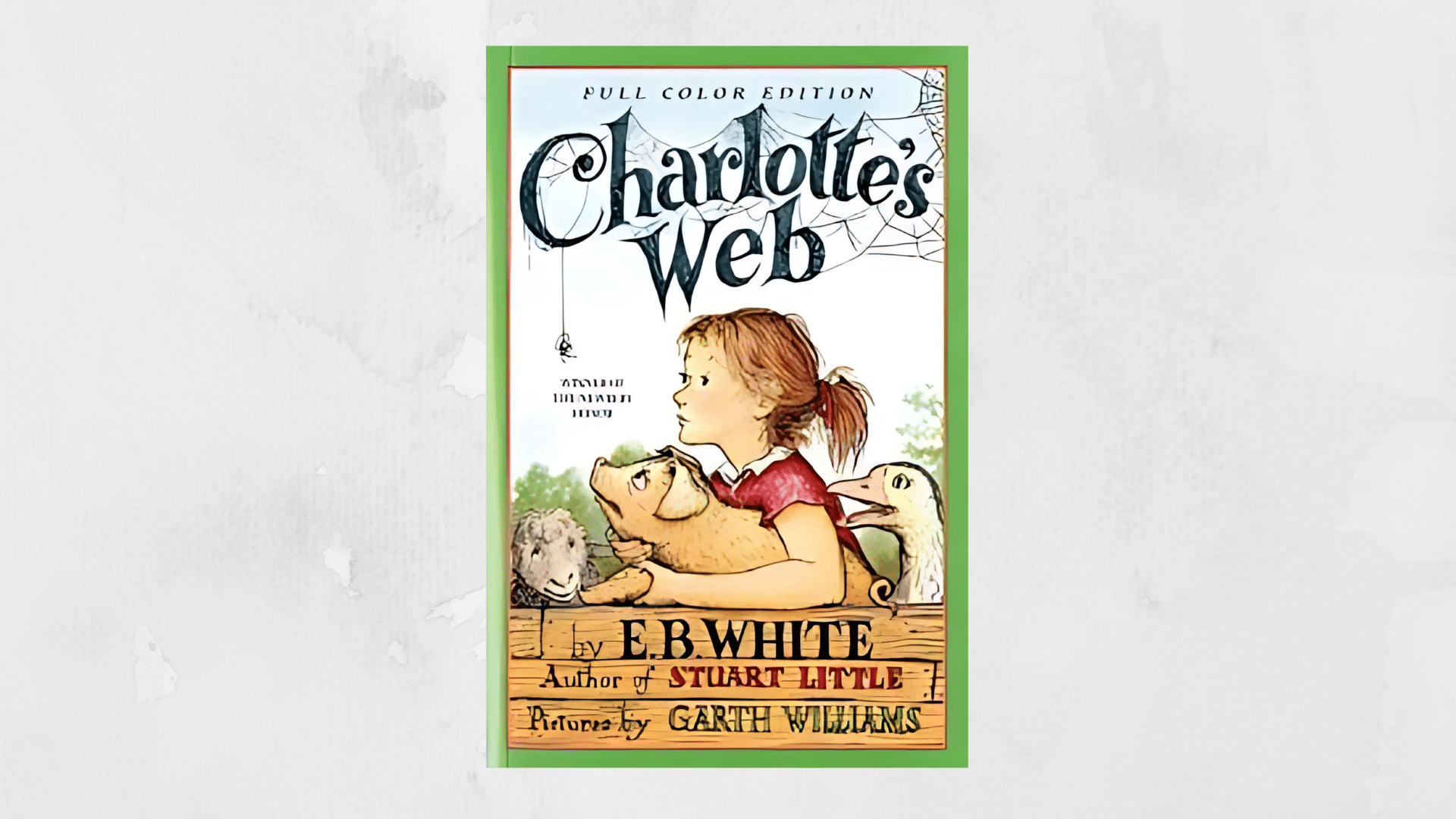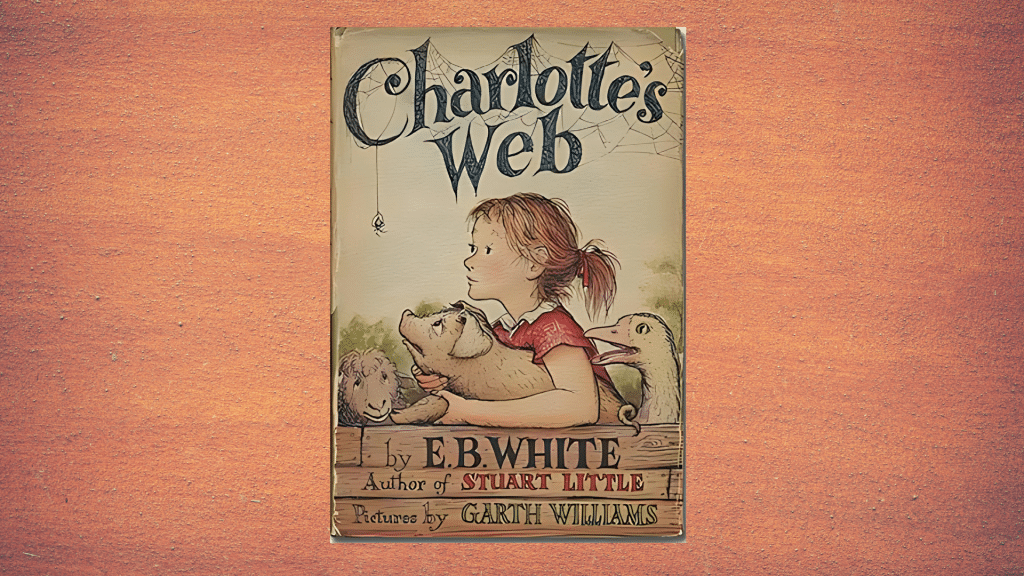Charlotte’s Web is one of the most beloved children’s books ever written. First published in 1952, it has touched millions of readers around the world with its gentle but meaningful story. The author, E.B. White, was already well known for Stuart Little before he wrote this book.
His writing shows the beauty of simple farm life while also sharing lessons that speak to both children and adults. The way he brings Wilbur the pig and Charlotte the spider to life makes the story unforgettable.
I believe this is why Charlotte’s Web still feels important today. Many people look for a Charlotte’s Web summary not only to recall the story but also to understand its themes.
Overview of Charlotte’s Web
- Author: E.B. White
- Published: 1952
- Genre: Children’s literature, fantasy
- Awards: Newbery Honor (1953), Lewis Carroll Shelf Award (1958)
- Setting: Primarily on the Zuckerman farm, with key scenes at the County Fair
Plot Summary
The story begins with a young girl named Fern saving a runt piglet from being killed. She names him Wilbur and cares for him until he grows too big. Wilbur is then sold to her uncle, Mr. Zuckerman, and moved to the farm.
At the farm, Wilbur feels lonely until he meets Charlotte, a wise and kind spider who lives in the barn. They quickly form a close friendship. Charlotte learns that Wilbur is being raised for slaughter and promises to find a way to save him.
She spins words like “Some Pig” and “Terrific” into her web, convincing everyone that Wilbur is extraordinary. His fame spreads, and he is taken to the County Fair, where his future is secured.
Before the fair ends, Charlotte dies after laying her eggs. Wilbur is heartbroken but protects her egg sac. When the eggs hatch, most baby spiders fly away, but three stay with him. This ensures Charlotte’s memory and their friendship live on.
Chapter-by-Chapter Summary of Charlotte’s Web

For easier understanding of Charlotte’s Web summary, the story is divided into chapter groups that show the key events step by step:
Chapters 1–5: Wilbur’s Beginning
These chapters introduce Wilbur and show how he finds his first home. Fern saves the runt piglet from her father and names him Wilbur. She raises him like a pet, feeding him with a bottle, but as he grows, he becomes too large to stay.
Wilbur is then sold to the Zuckerman farm. Once there, he feels lonely and longs for a friend until he meets Charlotte, a kind spider who promises to stay by his side.
Chapters 6–10: Friendship and Danger
Here, Wilbur’s life at the farm changes when he learns his future is in danger. Though he enjoys life in the barn, he finds that he is being raised for slaughter.
This frightens him, and he turns to Charlotte for help. Charlotte assures him that she has a plan to save his life. During this time, Templeton the rat appears, showing himself as greedy but sometimes helpful, while Fern continues to visit the farm and listen to the animals.
Chapters 11–15: Charlotte’s Plan
Charlotte begins carrying out her idea to protect Wilbur. She spins words into her web, starting with “Some Pig.” The Zuckermans and neighbors are stunned by what they see, believing it to be a miracle.
Wilbur’s fame grows as people come from near and far to look at him. Charlotte continues her work by adding new words like “Terrific” and “Radiant.” These messages convince everyone that Wilbur is truly special, giving him hope that his life will be spared.
Chapters 16–20: The County Fair
This part of the story takes Wilbur and Charlotte beyond the farm to the County Fair. Wilbur is taken there with Charlotte and Templeton, who reluctantly agree to help. Charlotte, now weak, creates one final web.
Templeton gathers words from scraps of paper, which Charlotte uses in her web. At the fair, Wilbur wins admiration and is promised a safe future. During this time, Charlotte quietly lays her egg sac, knowing her life is coming to an end.
Chapters 21–22: Charlotte’s Legacy
The final chapters close Wilbur’s story with sadness and hope. Charlotte dies at the fair, leaving Wilbur heartbroken. Still, he carries her egg sac back to the farm and carefully protects it through the winter. In spring, the eggs hatch, and hundreds of tiny spiders fill the barn.
Most float away on their silk threads, but three young spiders stay with Wilbur. Their presence gives him comfort and ensures that Charlotte’s memory and love live on.
Charlotte’s Web: Characters & Their Roles
The characters in Charlotte’s Web each play an important part in shaping the story. They highlight friendship, sacrifice, and change.
- Wilbur: The pig at the center of the story. He starts off small and weak but grows in strength and character. His innocence shows the need for protection, while his loyalty to Charlotte reflects love and gratitude.
- Charlotte: A wise spider who becomes Wilbur’s closest friend. She saves his life by spinning words into her web. Her actions show sacrifice and selflessness, even as her life ends.
- Fern: The young girl who first saves Wilbur. She represents childhood innocence and the bond between humans and animals. Her fading visits reflect the changes of growing up.
- Templeton: A selfish rat who enjoys food and hoarding. Though reluctant, he helps Charlotte’s plan by gathering words, proving even self-interest can serve a purpose.
- Supporting Roles: The Zuckerman family owns the farm and reacts to Charlotte’s web. Other barn animals add humor and give the farm its lively setting.
Themes & Lessons in Charlotte’s Web
The story of Charlotte’s Web carries lessons that remain meaningful for both children and adults.
- Friendship and Loyalty: The bond between Wilbur and Charlotte shows how true friendship means standing by someone in times of need. It teaches readers the value of kindness and trust in relationships.
- Life and Death Cycle: The Charlotte’s death reflects the natural cycle of life. It helps children understand that endings are part of growth and new beginnings.
- Sacrifice and Bravery: Charlotte gives her time and strength to save Wilbur, even as her own life fades. Her courage shows that real bravery often comes from helping others.
- Change and Growing Up: Fern’s fading interest in the barn reflects how people move on as they grow. It shows that change is natural, even when it feels difficult.
- Moral in Real Life: Kids learn that loyalty and care for others matter more than fame. Adults see the value of selflessness, patience, and letting go when the time comes.
Where to Read the Book
If you’d like to read Charlotte’s Web in full, here are some helpful options:
Buy a Copy: The book is widely available on Amazon, Barnes & Noble, and other online bookstores in paperback, hardcover, and digital editions.
Local Library: Most school and community libraries carry Charlotte’s Web. Borrowing is a great option for students and families.
Audiobook: The story is also available as an audiobook on Audible and other platforms, making it easy to enjoy on the go.
E-Book Versions: Digital copies can be found on Kindle, Apple Books, and Google Books for quick access.
About the Author

Elwyn Brooks White was an American writer best known for his children’s books Charlotte’s Web, Stuart Little, and The Trumpet of the Swan. He also wrote essays for The New Yorker and helped revise The Elements of Style, a famous writing guide.
White wrote Charlotte’s Web in the early 1950s. He had a farm in Maine, where he spent time watching animals and nature. His experiences with pigs and the natural cycle of life inspired him to create the story of Wilbur and Charlotte.
The book was first published in 1952 and became an instant classic. It won awards, sold millions of copies, and has been translated into many languages.
Today, it is still considered one of the most important works in children’s literature for its warmth, honesty, and timeless themes.
Adaptations Beyond the Book
The story of Charlotte’s Web has been brought to life outside the book many times. The first major adaptation was the 1973 animated film, which introduced the story to a new generation of children.
A sequel called Charlotte’s Web 2: Wilbur’s Great Adventure was released in 2003 as an animated film. While not as popular as the original, it gave fans another look at Wilbur’s life after Charlotte.
In 2006, a live-action film starring Dakota Fanning was released, mixing real actors with computer-animated animals. Both movies helped keep the story alive for families worldwide.
Over the years, Charlotte’s Web has become part of popular culture. It is taught in schools, quoted in classrooms, and referenced in TV shows, theater, and everyday conversations about friendship and loyalty.
Conclusion
Charlotte’s Web is more than a children’s story; it is a book that continues to teach readers about loyalty, courage, and the cycle of life.
This Charlotte’s Web summary shows how Elwyn Brooks White created characters that feel real and a message that still matters today.
Wilbur’s growth, Charlotte’s sacrifice, and the lessons of change remind us why the book has never lost its place in schools and homes. Reading the story gives both children and adults a chance to think about what it means to be a true friend.
If you found this summary helpful, take a look at my other blogs for more book summaries and study resources that can support your reading.
Frequently Asked Questions
What grade level is Charlotte’s Web best for?
The book is usually recommended for grades 3–6. However, its themes make it enjoyable and meaningful for older readers too
Is Charlotte’s Web based on real life?
E.B. White was inspired by his farm in Maine. He cared for pigs and observed spiders, which gave him the idea for Wilbur and Charlotte’s story.
Why is Charlotte’s Web considered a classic?
It combines a simple farm story with deep themes of friendship, sacrifice, and life’s natural cycle. Its universal message has kept it popular for over 70 years.











